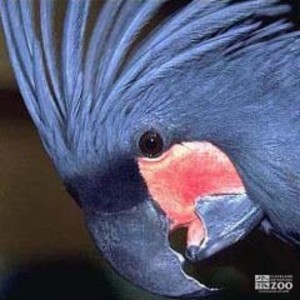Palm Cockatoo
[Probosciger aterrimus]

The Palm Cockatoo has an overall length of about 22 inches, with the tail measuring from 8 to 10 inches. Weight can range from 1 to 2 pounds. The general coloration is black, both above and below. The feathers are heavily coated with powder-down, giving a bluish-gray appearance. The prominent backward-curving crest is usually raised immediately after alighting, and also when alarmed or excited.
They generally roost in the topmost branches of tall trees on the edge of the rainforest. Before leaving the roosting tree they spend some time preening. About an hour after sunrise they begin calling to each other, and parties of six or seven congregate in a tall tree. They feed in the open woodland until mid-morning, then shelter in the rainforest. At nightfall they return to their roosting sites. Median Life expectancy is up to 60 years.
Location: Animals Formerly at Zoo
Share:
Range
The Palm Cockatoo's range is Northern Queensland, New Guinea, and the Aru Islands in Indonesia.
Habitat
The habitat of the palm cockatoo is the tropical rainforest.
Conservation Status
Least ConcernPrimary Threats
Gestation
The incubation of the eggs is 31 to 35 days.
Litter
One egg, every second year.Behavior
The crest of the palm cockatoo is usually raised immediately after alighting, and also when alarmed or excited. They generally roost in the topmost branches of tall trees on the edge of the rain forest. They seem to prefer trees with leafless upper branches. They do not stir until well after sunrise. Before leaving the roosting tree they spend some time preening. About an hour after sunrise they begin calling to each other, and parties of six or seven congregate in a tall tree. They feed in the open woodland until mid-morning, then shelter in the rain forest. At nightfall they return to their roosting sites. When excited, the red of the cheek patch deepens, and the bird is said to "blush". Normal flight is heavy and labored, with slow, full wingbeats and the bill held down against the breast. When coming in to alight they glide directly into the tree. The alarm call is a short, harsh screech. They bathe by fluttering among the wet foliage of a tree, or during rain showers by flying about, or hanging upside-down from their perches. When cornered or aroused, they emit a peculiar hissing noise.
Reproduction
The breeding season of the palm cockatoo is prolonged, and may vary in accordance with climatic conditions. They have one of the lowest breeding prates of any parrot. The nest is a hollow limb or a hole in the trunk of a tree. The bottom of the hollow is lined with a layer of splintered twigs. The single egg is laid on the layer of twigs. After hatching the young bird remains in the nest for 100 to 110 days. For two weeks after emergence it is capable of only weak, unsteady flight, and is fed by the parents for a further six weeks. When excited, the red of the cheek patch deepens, and the bird is said to "blush". The alarm call is a short, harsh screech and they also emit a peculiar hissing noise. Normal flight is heavy and labored, with slow, full wingbeats and the bill held down against the breast. When coming in to alight they glide directly into the tree. They bathe by fluttering among the wet foliage of a tree, or during rain showers by flying about, or hanging upside-down from their perches. The breeding season is prolonged, and may vary in accordance with climatic conditions. The nest is a hollow limb or a hole in the trunk of a tree. The bottom of the hollow is lined with a layer of splintered twigs. The single egg is laid on the layer of twigs. After hatching the young bird remains in the nest for 100 to 110 days. For two weeks after emergence from the nest it is capable of only weak, unsteady flight, and is fed by the parents for a further six weeks.Wild Diet
Their diet in the wild includes seeds, nuts, fruits, berries, leaf buds, insects and insect larvae.
